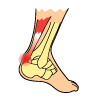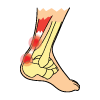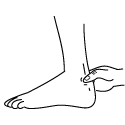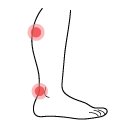What is Achilles Tendonitis?
Achilles Tendonitis occurs when the Achilles Tendon in the back of your ankle becomes irritated and inflamed. This is usually due to overuse.
There are two types of Achilles Tendonitis, affecting two different areas of the tendon. These are:
Insertional Achilles Tendonitis
Insertional Achilles Tendonitis affects the tendon at the insertion point of the heel bone. This type of tendonitis is not usually associated with a specific injury and is more common in people who are 40+ years old.
Non-Insertional Achilles Tendonitis
Non-insertional Achilles Tendonitis can affect one or more areas in the middle of the Achilles Tendon. This type of tendonitis is more common among young, active people.
Causes
Insertional Achilles Tendonitis
Insertional Achilles Tendonitis is often caused by degeneration of the tissue over time rather than an injury. As we age, our Achilles Tendon will grow weaker and become more susceptible to tearing. Conditions such as Heel Spurs, Retrocalcaneal Bursitis, Reiter’s Syndrome and Haglund’s Deformity also put you at greater risk of developing Insertional Achilles Tendonitis.
 Non-Insertional Achilles Tendonitis
Non-Insertional Achilles Tendonitis
Sports that involve a lot of running and jumping can cause repetitive strain on the Achilles Tendon, leading to the development of tears. Achilles Tendonitis is often seen in sports such as basketball, soccer, football and rugby. Things like an improper warm-up or worn-out shoes can also contribute to Achilles Tendonitis.
Signs & Symptoms
Insertional Achilles Tendonitis
Most people with Insertional Achilles Tendonitis will notice the pain coming on gradually. The pain will be located on the back of the heel and, at first, will only be noticed during physical activity. The pain will be especially noticeable when participating in running and jumping sports. The back of the heel area may also be tender to the touch.
 Non-Insertional Achilles Tendonitis
Non-Insertional Achilles Tendonitis
The pain is noticed up higher with Non-insertional Achilles Tendonitis, usually in the middle of the Achilles or the back of the calf. Like with Insertional Achilles Tendonitis, the pain will come on gradually and worsen over time. The back of your ankle may also be warm and tender to the touch.
Treatment Options
RICE – Rest, Ice, Compression & Elevation is effective for treating both Insertional and Non-insertional Achilles Tendonitis. Resting your Achilles will help prevent further aggravation of the tissue. Ice and Compression work together to relieve pain and swelling. Elevating your ankle will work to further relieve your inflammation.
Painkillers – NSAIDs (non-steroidal anti-inflammatory drugs) such as Advil (ibuprofen) and Aleve (naproxen)work to alleviate both pain and swelling. Tylenol (acetaminophen) is an analgesic and while it will relieve pain, it won’t do anything for your inflammation.
 Proper Footwear – Wearing high heels or shoes that are too tight can cause unnecessary strain on the Achilles Tendon. Look for shoes that are not too tight or too loose. Wear shoes that are flat. If your shoes are worn out, trade them in for a new pair.
Proper Footwear – Wearing high heels or shoes that are too tight can cause unnecessary strain on the Achilles Tendon. Look for shoes that are not too tight or too loose. Wear shoes that are flat. If your shoes are worn out, trade them in for a new pair.
Physiotherapy – Doing certain exercises can help contribute to healing. Just make sure you listen to your body and don’t try to do the exercises too soon in the healing process. If the exercise hurts, don’t do it!
Surgery – While conservative treatment is enough to heal most cases of Achilles Tendonitis, if you have a full tendon tear (the tissue is in two separate pieces), you should talk to your doctor about your options for surgery. Also, if you find that your Achilles Tendonitis still hasn’t healed after several months of conservative treatment, you may need to consider surgery.